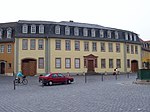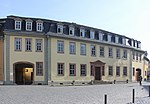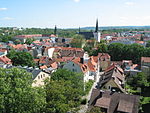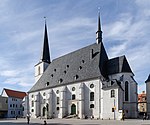Haus am Horn

The Haus am Horn is a domestic house in Weimar, Germany, designed by Georg Muche. It was built for the Bauhaus Werkschau (English: Work show) exhibition which ran from July to September 1923. It was the first building based on Bauhaus design principles, which revolutionized 20th century architectural and aesthetic thinking and practice.In keeping with the Bauhaus philosophy of teaching via practical experience and working with industry, a number of students were involved with the building project.In 1996 the building was inscribed as part of the UNESCO World Heritage Site now called the Bauhaus and its Sites in Weimar, Dessau and Bernau, because of its testimony to the architectural influence of the Bauhaus movement.
Excerpt from the Wikipedia article Haus am Horn (License: CC BY-SA 3.0, Authors, Images).Haus am Horn
Am Horn,
Geographical coordinates (GPS) Address External links Nearby Places Show on map
Geographical coordinates (GPS)
| Latitude | Longitude |
|---|---|
| N 50.973888888889 ° | E 11.339444444444 ° |
Address
Haus am Horn
Am Horn
99425 , Parkvorstadt
Thuringia, Germany
Open on Google Maps











